Frequency Division Multiplexing of Terahertz Waves Realized by Diffractive Optical Elements
Abstract
:1. Introduction
2. Materials and Methods
2.1. Design
2.2. Numerical Simulations
2.3. Manufacturing
3. Results
3.1. Experimental Setup
3.2. Focal Spots
3.3. Multiplexing with Frequency Division
4. Conclusions
Author Contributions
Funding
Data Availability Statement
Conflicts of Interest
Abbreviations
| DOE | Diffractive Optical Element |
| DWL | Design Wavelength |
| MIMO | Multiple Input Multiple Output |
| SDM | Space Division Multiplexing |
| WDM | Wavelength Division Multiplexing |
| FDM | Frequency Division Multiplexing |
| SLS | Selective Laser Sintering |
| FDM* | Fused Deposition Modeling |
| DLP | Digital Light Processing |
| PP | Polypropylene |
| HIPS | High Impact Polystyrene |
| THz-TDS | THz Time Domain Spectroscopy |
| PSD | Power Spectral Density |
References
- Mittleman, D.M. Twenty years of terahertz imaging [Invited]. Opt. Express 2018, 26, 9417. [Google Scholar] [CrossRef] [PubMed]
- Pawar, A.Y.; Sonawane, D.D.; Erande, K.B.; Derle, D.V. Terahertz technology and its applications. Drug Invent. Today 2013, 5, 157–163. [Google Scholar] [CrossRef]
- Hafez, H.A.; Chai, X.; Ibrahim, A.; Mondal, S.; Férachou, D.; Ropagnol, X.; Ozaki, T. Intense terahertz radiation and their applications. J. Opt. 2016, 18, 093004. [Google Scholar] [CrossRef]
- Tao, Y.H.; Fitzgerald, A.J.; Wallace, V.P. Non-contact, non-destructive testing in various industrial sectors with terahertz technology. Sensors 2020, 20, 712. [Google Scholar] [CrossRef] [Green Version]
- Fan, S.; Li, T.; Zhou, J.; Liu, X.; Liu, X.; Qi, H.; Mu, Z. Terahertz non-destructive imaging of cracks and cracking in structures of cement-based materials. AIP Adv. 2017, 7, 115202. [Google Scholar] [CrossRef] [Green Version]
- Catapano, I.; Soldovieri, F.; Mazzola, L.; Toscano, C. THz Imaging as a Method to Detect Defects of Aeronautical Coatings. J. Infrared Millimeter Terahertz Waves 2017, 38, 1264–1277. [Google Scholar] [CrossRef]
- Zhong, S. Progress in terahertz nondestructive testing: A review. Front. Mech. Eng. 2018, 14, 273–281. [Google Scholar] [CrossRef]
- Pickwell, E.; Wallace, V.P. Biomedical applications of terahertz technology. J. Phys. D Appl. Phys. 2006, 39. [Google Scholar] [CrossRef]
- Yu, C.; Fan, S.; Sun, Y.; Pickwell-Macpherson, E. The potential of terahertz imaging for cancer diagnosis: A review of investigations to date. Quant. Imaging Med. Surg. 2012, 2, 33–45. [Google Scholar] [CrossRef]
- Sung, S.; Selvin, S.; Bajwa, N.; Chantra, S.; Nowroozi, B.; Garritano, J.; Goell, J.; Li, A.D.; Deng, S.X.; Brown, E.R.; et al. THz Imaging System for in vivo Human Cornea. IEEE Trans. Terahertz Sci. Technol. 2018, 8, 27–37. [Google Scholar] [CrossRef] [PubMed]
- Mehdi, I.; Siles, J.; Chen, C.P.; Jornet, J.M. THz technology for space communications. In Proceedings of the Asia-Pacific Microwave Conference Proceedings, APMC, Kyoto, Japan, 6–9 November 2019; pp. 76–78. [Google Scholar] [CrossRef]
- Saeed, A.; Gurbuz, O.; Akkas, M.A. Terahertz communications at various atmospheric altitudes. Phys. Commun. 2020, 41, 101113. [Google Scholar] [CrossRef]
- Piesiewicz, R.; Jacob, M.; Koch, M.; Schoebel, J.; Kürner, T. Performance analysis of future multigigabit wireless communication systems at THz frequencies with highly directive antennas in realistic indoor environments. IEEE J. Sel. Top. Quantum Electron. 2008, 14, 421–430. [Google Scholar] [CrossRef]
- Irahhauten, Z.; Nikookar, H.; Janssen, G.J. An overview of ultra wide band indoor channel measurements and modeling. IEEE Microw. Wirel. Compon. Lett. 2004, 14, 386–388. [Google Scholar] [CrossRef] [Green Version]
- O’Hara, J.F.; Ekin, S.; Choi, W.; Song, I. A perspective on terahertz next-generation wireless communications. Technologies 2019, 7, 43. [Google Scholar] [CrossRef] [Green Version]
- Richardson, D.J.; Fini, J.M.; Nelson, L.E. Space-division multiplexing in optical fibres. Nat. Photonics 2013, 7, 354–362. [Google Scholar] [CrossRef] [Green Version]
- Heath, R.W.; Paulraj, A.J. Switching between diversity and multiplexing in MIMO systems. IEEE Trans. Commun. 2005, 53, 962–972. [Google Scholar] [CrossRef]
- Jansen, S.L.; Morita, I.; Schenk, T.C.; Tanaka, H. Long-haul transmission of 16 × 52.5 Gbits/s polarization-division-multiplexed OFDM enabled by MIMO processing. J. Opt. Netw. 2008, 7, 173–182. [Google Scholar] [CrossRef]
- Kaiser, S. OFDM code-division multiplexing in fading channels. IEEE Trans. Commun. 2002, 50, 1266–1273. [Google Scholar] [CrossRef]
- Baghdady, J.; Miller, K.; Morgan, K.; Byrd, M.; Osler, S.; Ragusa, R.; Li, W.; Cochenour, B.M.; Johnson, E.G. Multi-gigabit/s underwater optical communication link using orbital angular momentum multiplexing. Opt. Express 2016, 24, 9794. [Google Scholar] [CrossRef] [PubMed]
- Michailow, N.; Matthe, M.; Gaspar, I.S.; Caldevilla, A.N.; Mendes, L.L.; Festag, A.; Fettweis, G. Generalized frequency division multiplexing for 5th generation cellular networks. IEEE Trans. Commun. 2014, 62, 3045–3061. [Google Scholar] [CrossRef]
- Hoseini, S.A.; Ding, M.; Hassan, M. Massive MIMO Performance Comparison of Beamforming and Multiplexing in the Terahertz Band. In Proceedings of the 2017 IEEE Globecom Workshops, GC Wkshps 2017, Singapore, 4–8 December 2017; pp. 1–6. [Google Scholar] [CrossRef] [Green Version]
- Busari, S.A.; Huq, K.M.S.; Mumtaz, S.; Rodriguez, J.; Fang, Y.; Sicker, D.C.; Al-Rubaye, S.; Tsourdos, A. Generalized Hybrid Beamforming for Vehicular Connectivity Using THz Massive MIMO. IEEE Trans. Veh. Technol. 2019, 68, 8372–8383. [Google Scholar] [CrossRef]
- Tan, J.; Dai, L. Delay-phase precoding for THz massive MIMO with beam split. In Proceedings of the 2019 IEEE Global Communications Conference (GLOBECOM), Waikoloa, HI, USA, 9–13 December 2019; pp. 1–6. [Google Scholar] [CrossRef]
- Cheng, C.L.; Sangodoyin, S.; Zajic, A. THz MIMO channel characterization for wireless data center-like environment. In Proceedings of the 2019 IEEE International Symposium on Antennas and Propagation and USNC-URSI Radio Science Meeting, Atlanta, GA, USA, 7–12 July 2019; pp. 2145–2146. [Google Scholar] [CrossRef]
- Oshima, N.; Hashimoto, K.; Suzuki, S.; Asada, M. Terahertz wireless data transmission with frequency and polarization division multiplexing using resonant-tunneling-diode oscillators. IEEE Trans. Terahertz Sci. Technol. 2017, 7, 593–598. [Google Scholar] [CrossRef]
- Wang, B.; Quan, B.; He, J.; Xie, Z.; Wang, X.; Li, J.; Kan, Q.; Zhang, Y. Wavelength de-multiplexing metasurface hologram. Sci. Rep. 2016, 6. [Google Scholar] [CrossRef]
- Machado, F.; Zagrajek, P.; Ferrando, V.; Monsoriu, J.A.; Furlan, W.D. Multiplexing thz vortex beams with a single diffractive 3D printed lens. IEEE Trans. Terahertz Sci. Technol. 2019, 9, 63–66. [Google Scholar] [CrossRef]
- Wei, X.; Zhu, L.; Zhang, Z.; Wang, K.; Liu, J.; Wang, J. Orbit Angular Momentum Multiplexing in 0.1-THz Free-Space Communication via 3D Printed Spiral Phase Plates. In Proceedings of the 2014 Conference on Lasers and Electro-Optics (CLEO)—Laser Science to Photonic Applications, San Jose, CA, USA, 8–13 June 2014. [Google Scholar] [CrossRef]
- Siemion, A. The Magic of Optics—An Overview of Recent Advanced Terahertz Diffractive Optical Elements. Sensors 2020, 21, 100. [Google Scholar] [CrossRef] [PubMed]
- Siemion, A. Terahertz Diffractive Optics—Smart Control over Radiation. J. Infrared Millimeter Terahertz Waves 2019, 40, 477–499. [Google Scholar] [CrossRef] [Green Version]
- Sahin, S.; Nahar, N.K.; Sertel, K. Dielectric Properties of Low-Loss Polymers for mmW and THz Applications. J. Infrared Millimeter Terahertz Waves 2019, 40, 557–573. [Google Scholar] [CrossRef]
- Castro-Camus, E.; Koch, M.; Hernandez-Serrano, A.I. Additive manufacture of photonic components for the terahertz band. J. Appl. Phys. 2020, 127, 210901. [Google Scholar] [CrossRef]
- Squires, A.D.; Lewis, R.A. Feasibility and Characterization of Common and Exotic Filaments for Use in 3D Printed Terahertz Devices. J. Infrared Millimeter Terahertz Waves 2018, 39, 614–635. [Google Scholar] [CrossRef] [Green Version]
- Sun, J.; Hu, F. Three-dimensional printing technologies for terahertz applications: A review. Int. J. RF Microw. Comput.-Aided Eng. 2019, 30. [Google Scholar] [CrossRef]
- Zhang, B.; Chen, W.; Wu, Y.; Ding, K.; Li, R. Review of 3D Printed Millimeter-Wave and Terahertz Passive Devices. Int. J. Antennas Propag. 2017, 2017, 1297931. [Google Scholar] [CrossRef] [Green Version]
- Duangrit, N.; Hong, B.; Burnett, A.D.; Akkaraekthalin, P.; Robertson, I.D.; Somjit, N. Terahertz Dielectric Property Characterization of Photopolymers for Additive Manufacturing. IEEE Access 2019, 7, 12339–12347. [Google Scholar] [CrossRef]
- Sypek, M. Light propagation in the Fresnel region. New numerical approach. Opt. Commun. 1995, 116, 43–48. [Google Scholar] [CrossRef]
- Komorowski, P.; Surma, M.; Walczakowski, M.; Zagrajek, P.; Siemion, A. Off-Axis Diffractive Optics for Compact Terahertz Detection Setup. Appl. Sci. 2020, 10, 8594. [Google Scholar] [CrossRef]
- Liebert, K.; Rachon, M.; Siemion, A.; Suszek, J.; However, D.; Knap, W.; Sypek, M. THz beam shaper realizing fan-out patterns. J. Infrared Millimeter Terahertz Waves 2017, 38, 1019–1030. [Google Scholar] [CrossRef] [Green Version]
- Komorowski, P.; Czerwińska, P.; Surma, M.; Zagrajek, P.; Piramidowicz, R.; Siemion, A. Three-focal-spot terahertz diffractive optical element-iterative design and neural network approach. Opt. Express 2021, 29, 11243–11253. [Google Scholar] [CrossRef]
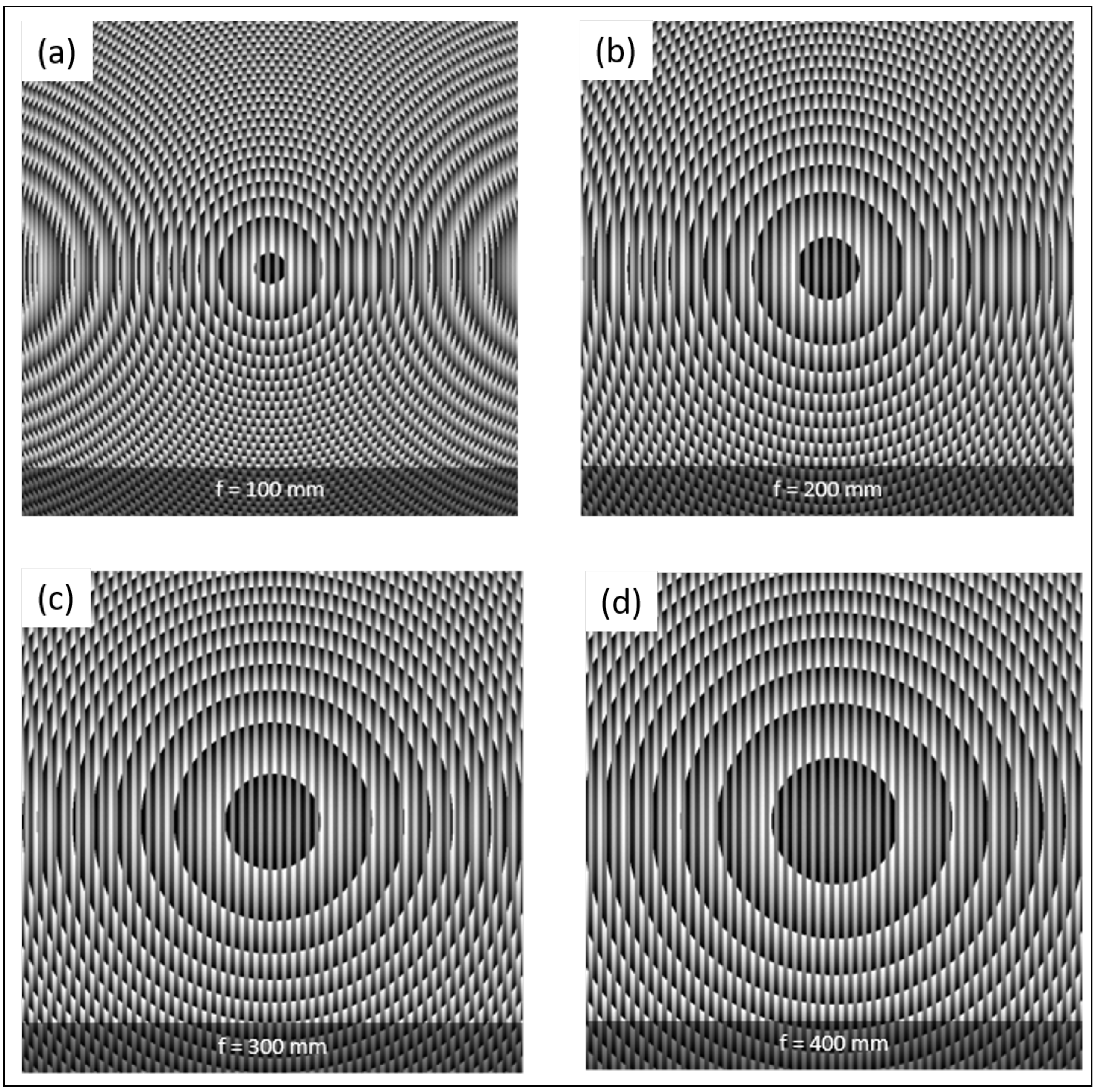
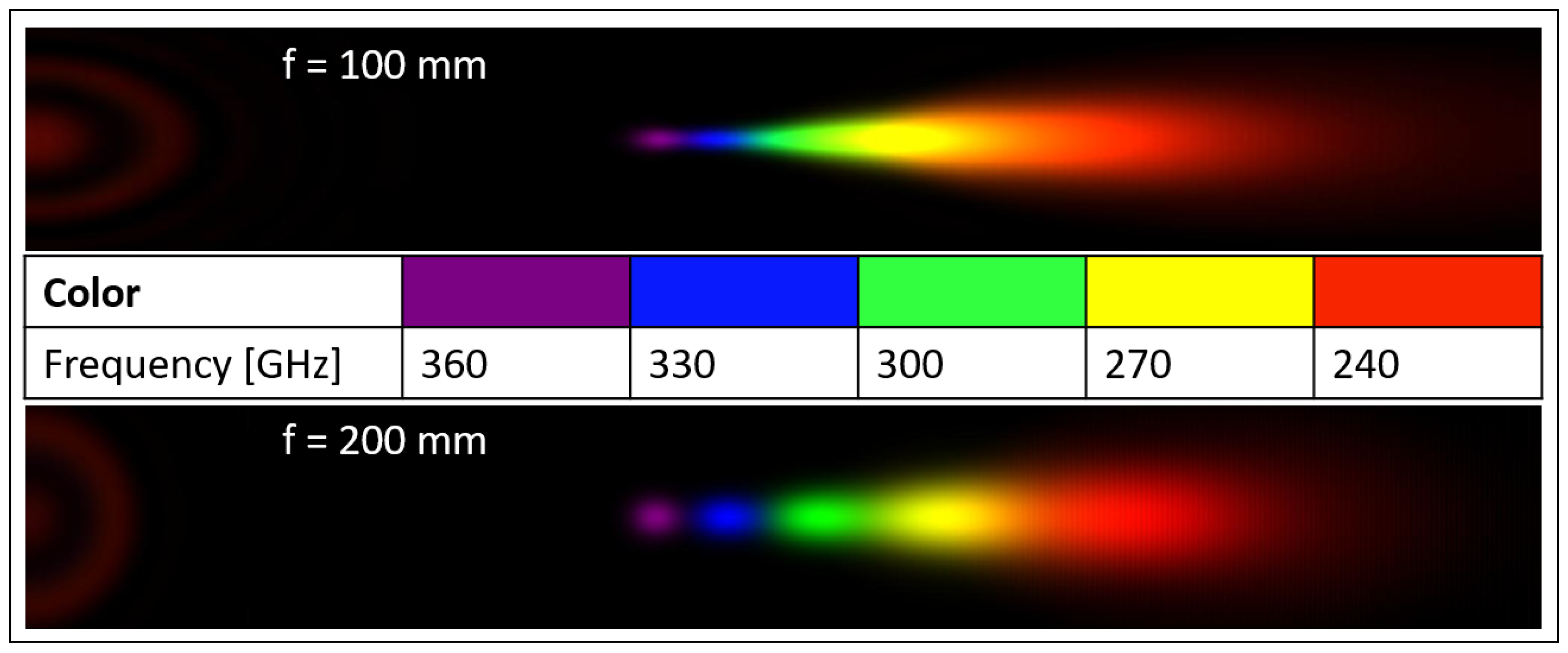

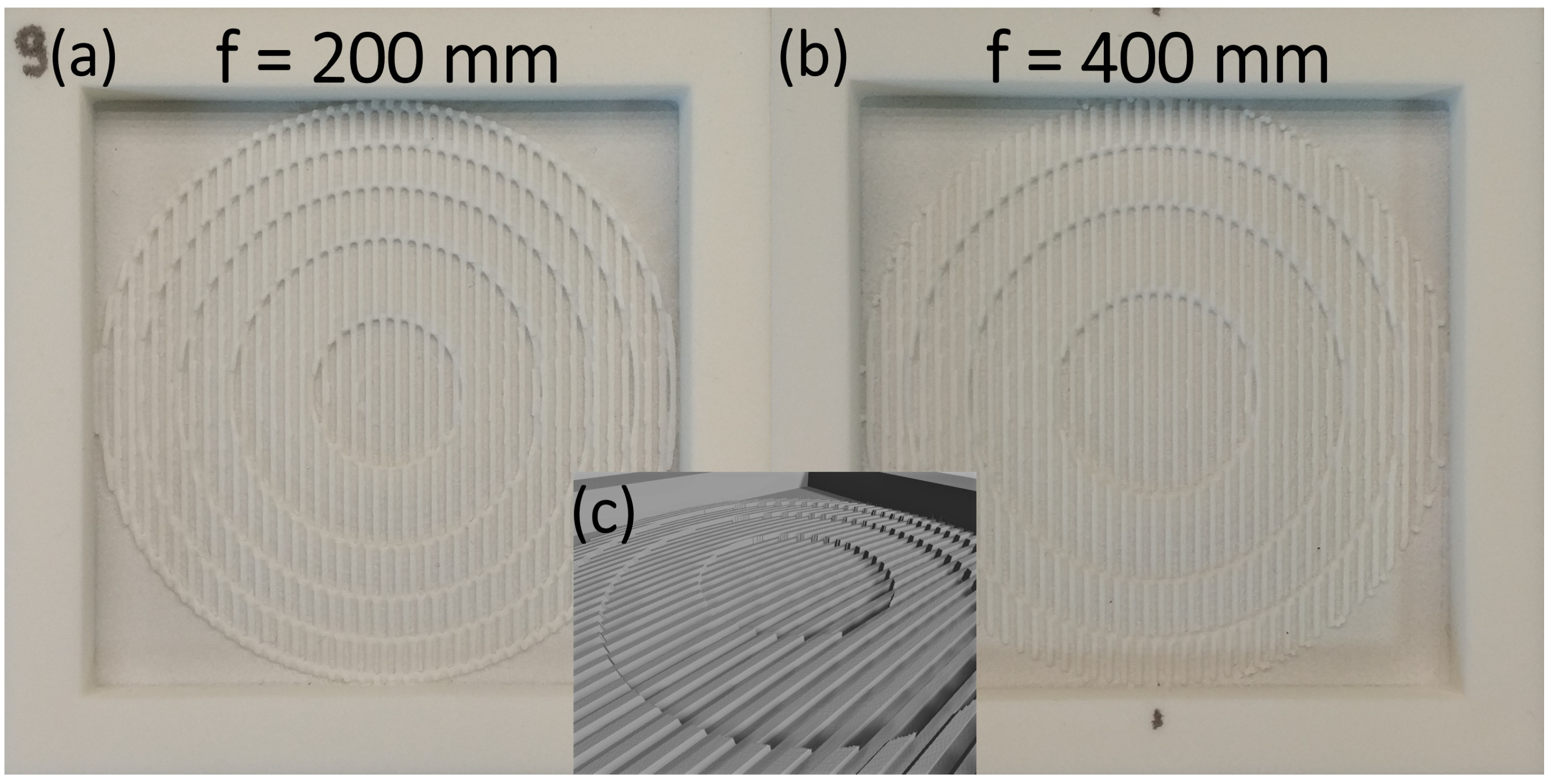
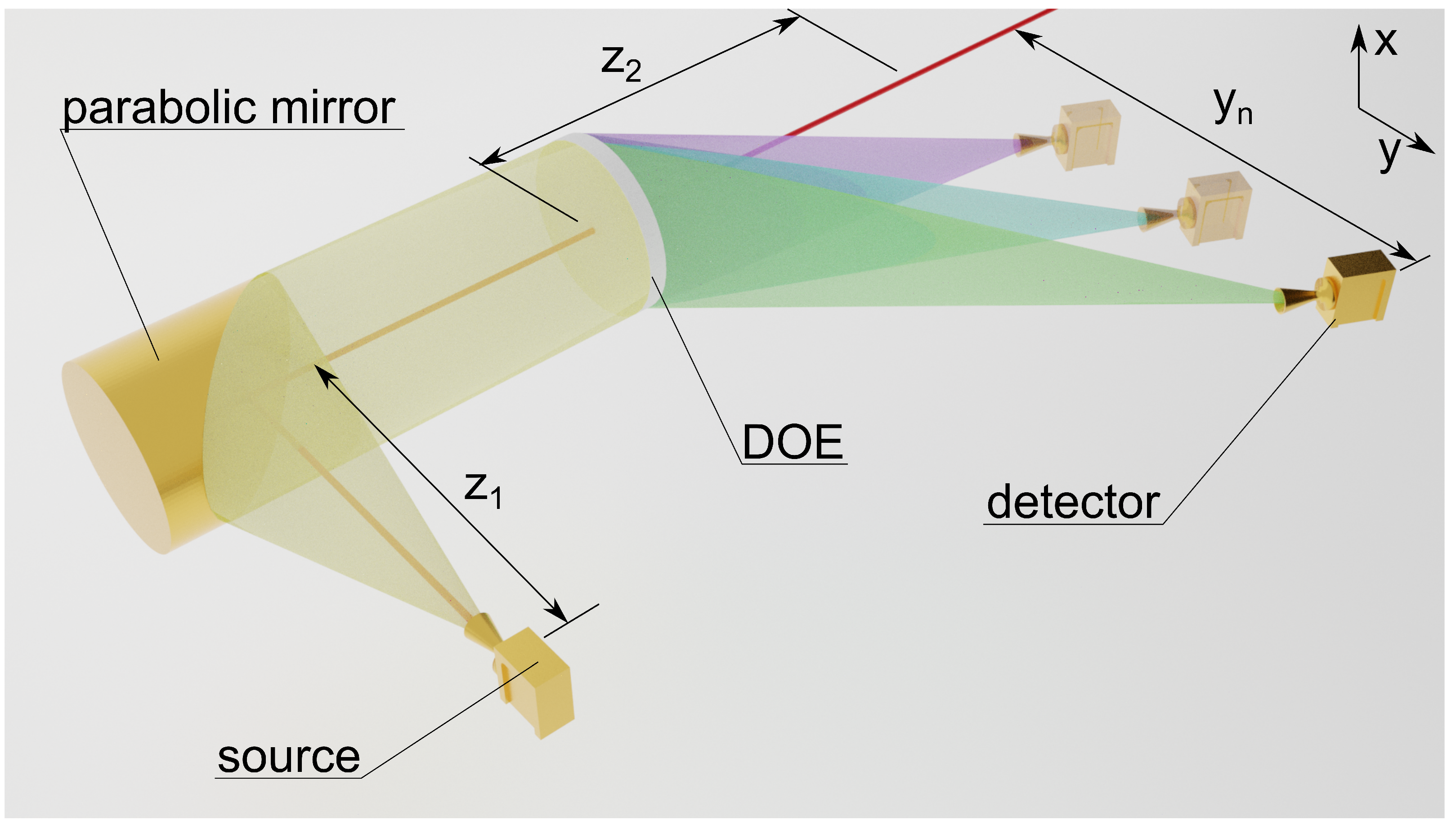


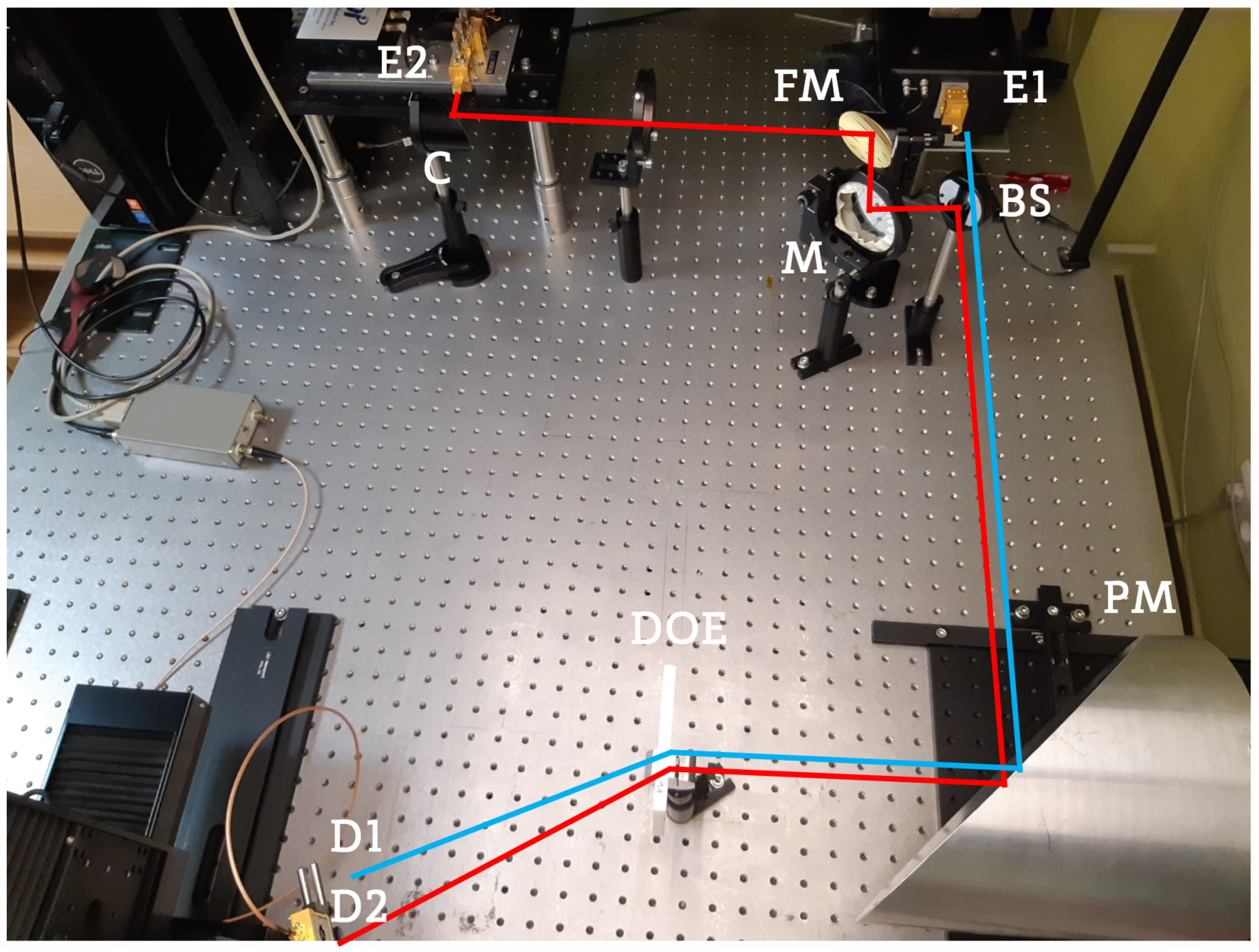
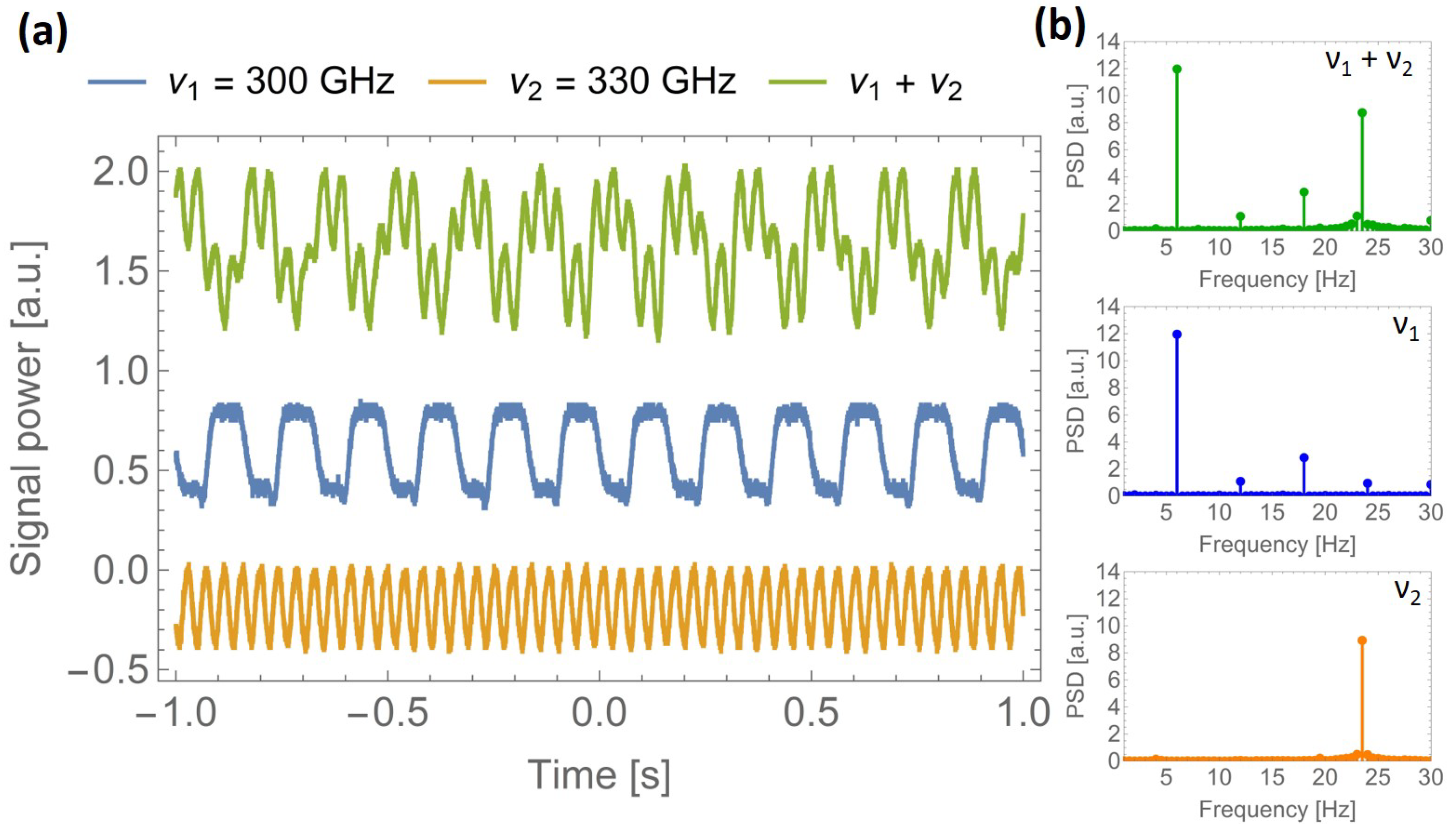
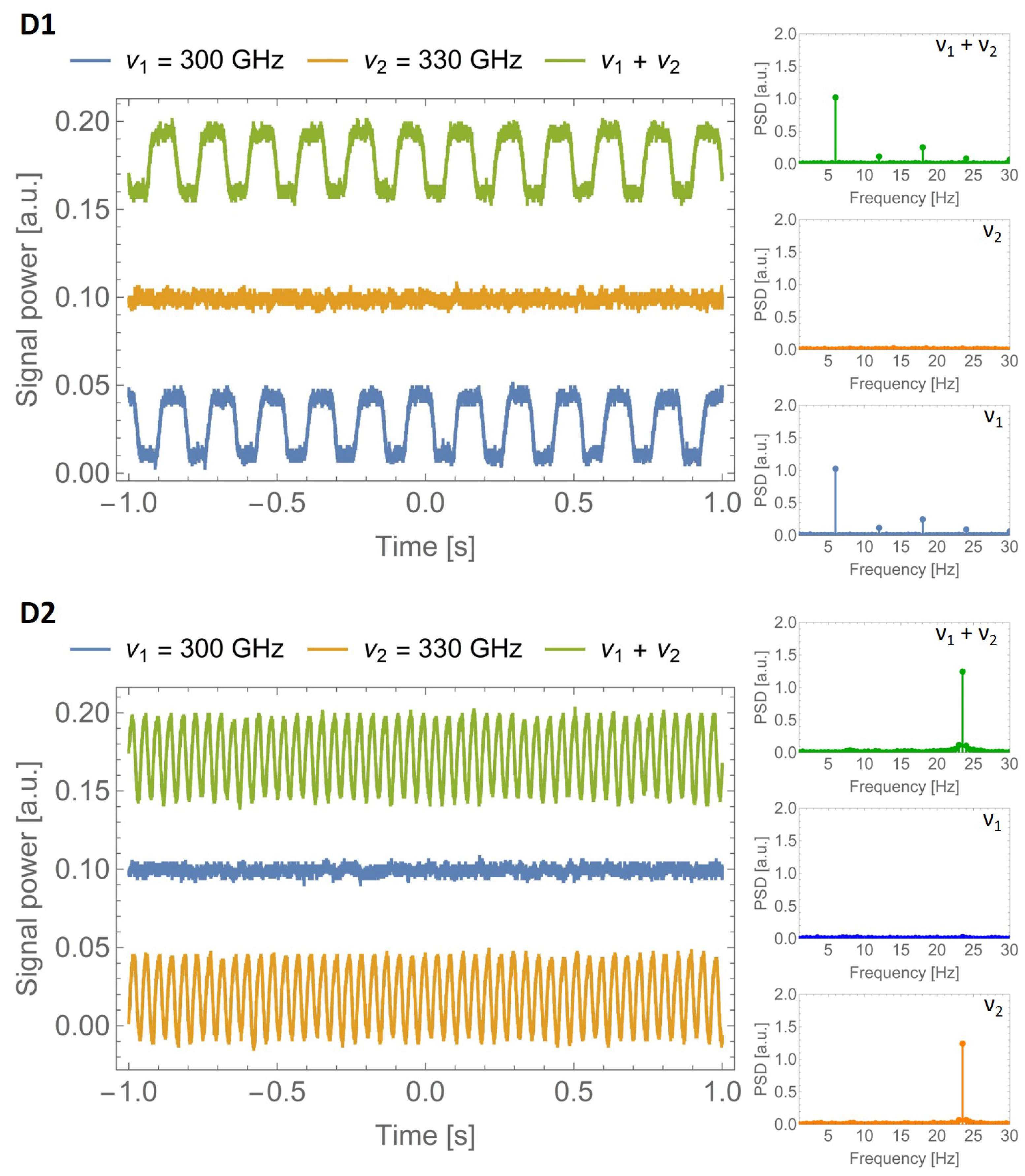
| Frequency [GHz] | 240 | 270 | 300 | 330 | 360 | 390 |
|---|---|---|---|---|---|---|
| Focal spot position [mm] (f = 200 mm) | ||||||
| Simulation | 177 | 145 | 126 | 109 | 95 | - |
| Experiment | 162 | 132 | 115 | 102 | 89 | - |
| Ratio | 0.92 | 0.91 | 0.91 | 0.94 | 0.94 | - |
| Focal spot position [mm] (f = 400 mm) | ||||||
| Simulation | 356 | 304 | 260 | 220 | 204 | 176 |
| Experiment | 204 | 177 | 154 | 132 | 116 | 101 |
| Ratio | 0.57 | 0.58 | 0.59 | 0.60 | 0.57 | 0.57 |
Publisher’s Note: MDPI stays neutral with regard to jurisdictional claims in published maps and institutional affiliations. |
© 2021 by the authors. Licensee MDPI, Basel, Switzerland. This article is an open access article distributed under the terms and conditions of the Creative Commons Attribution (CC BY) license (https://creativecommons.org/licenses/by/4.0/).
Share and Cite
Komorowski, P.; Czerwińska, P.; Kaluza, M.; Surma, M.; Zagrajek, P.; Sobczyk, A.; Ciurapiński, W.; Piramidowicz, R.; Siemion, A. Frequency Division Multiplexing of Terahertz Waves Realized by Diffractive Optical Elements. Appl. Sci. 2021, 11, 6246. https://doi.org/10.3390/app11146246
Komorowski P, Czerwińska P, Kaluza M, Surma M, Zagrajek P, Sobczyk A, Ciurapiński W, Piramidowicz R, Siemion A. Frequency Division Multiplexing of Terahertz Waves Realized by Diffractive Optical Elements. Applied Sciences. 2021; 11(14):6246. https://doi.org/10.3390/app11146246
Chicago/Turabian StyleKomorowski, Paweł, Patrycja Czerwińska, Mateusz Kaluza, Mateusz Surma, Przemysław Zagrajek, Artur Sobczyk, Wiesław Ciurapiński, Ryszard Piramidowicz, and Agnieszka Siemion. 2021. "Frequency Division Multiplexing of Terahertz Waves Realized by Diffractive Optical Elements" Applied Sciences 11, no. 14: 6246. https://doi.org/10.3390/app11146246
APA StyleKomorowski, P., Czerwińska, P., Kaluza, M., Surma, M., Zagrajek, P., Sobczyk, A., Ciurapiński, W., Piramidowicz, R., & Siemion, A. (2021). Frequency Division Multiplexing of Terahertz Waves Realized by Diffractive Optical Elements. Applied Sciences, 11(14), 6246. https://doi.org/10.3390/app11146246








